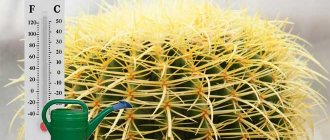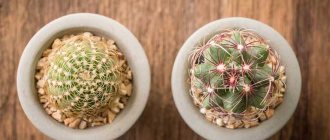Cacti are a special group of plants whose representatives are able to survive without water for as long as possible. Like other succulents, they collect moisture from the air and soil, and then accumulate it in the cells of the roots and thickened stems. The smooth, dense skin, covered with needles, prevents the evaporation of liquid, making it possible for these green “spines” to exist in the driest regions of the Earth. However, specimens growing on window sills and balconies still need periodic moistening. Read on to learn how to water cacti at home to make them look beautiful and healthy.
What water is suitable for irrigation?
Like most indoor flowers, cacti prefer soft water without chlorine or mineral salts. It is advisable to use settled or filtered liquid. If it is hard and leaves a white residue when boiled, then you can balance the acidity by adding a few drops of lemon juice or half a teaspoon of table vinegar per liter of H2O. It is also better to leave the melt or rain water so that excess impurities settle to the bottom and do not harm the plants.
20130718145203.jpg
The water temperature for watering succulents should not be lower than +20...25 °C in summer and +35...40°C in winter. If you neglect this rule, the plants will become overcooled and get sick. Such an omission will quickly affect the appearance of exotic pets - they will begin to darken and rot in the lower part of the stem.
5bd8e2e033c3a5bd8e2e036433.jpg
Feeding succulents correctly
Before fertilizing cacti, you need to get acquainted with the needs of these desert plants and find out how to do it so that fertilizing is “for the good”:
- Concentrated fertilizers should be diluted in filtered or settled water;
- if damaged by pests or any disease, indoor flowers are not fertilized, this also applies to succulents;
- you need to dose the preparations correctly, otherwise root rot may occur, the soil may be affected by pests, the shape of the flower changes and it does not bloom for a long time;
- It is advisable to spray the plant with nutrient mixtures during cloudy weather, this will eliminate the possibility of sunburn;
- there are situations when you should not fertilize the vegetation - immediately after transplanting or purchasing a flower, as well as in the first couple of weeks after rooting;
- before applying fertilizer to plants, experienced flower growers advise moistening the soil with water;
- succulents are not fertilized if they are standing under scorching sun rays, in the cold or in a draft;
- the nutrient mixture intended for application “under the root” should not fall on the above-ground parts of the plant, as it can burn its skin;
- the event will be effective if the “pet” grows in acidified soil, since with an increased amount of carbonate compounds in the soil or watering with water of increased hardness, it will grow poorly;
Although the plant will not tell you what it lacks or what it receives in excess, it can signal a nutritional disorder. If it stops growing, then most likely it is a lack of nitrogen. With a deficiency of iron or magnesium, succulents lose their bright color. This symptom is also observed if a flower from a shady place suddenly comes under intense sunlight. A solution of potassium phosphate is required if the succulent's buds, unopened inflorescences fall off, and the flowering process itself is poor.
How often should cacti be watered?
In nature, the cactus family rarely receives natural watering in the form of precipitation, but actively absorbs water molecules from the hot subequatorial air. A similar process can be carried out on the windowsill, but often the rooms are quite dry, and “atmospheric” humidification may not be enough.
pravila-ukhoda-za-kaktusami.jpeg
To understand how to water cacti at home in the summer, it is important to determine which group each specimen belongs to. Thus, desert species (astrophytum, cephalocereus, cleistrocactus, echinocereus, echinopsis, ferocactus, rebutia, etc.) require much less moisture than their forest relatives (zygocactus, epiphyllum, ripsalidopsis, pereskia, melocactus, hatiora, prickly pear). The reason is that the former have so-called “stomata” at the base of the needles, through which drops of water can get inside. The latter are content only with root nutrition.
risunok1.jpg
The watering schedule for cacti looks something like this:
- in winter - once a month;
- in spring and autumn – 2 times a month;
- in summer – once a week.
Humidification of forest species is carried out twice as often:
- from December to March – 2 times a month (weekly during the flowering period);
- in the off-season - every week;
- from June to September – once every 3-4 days.
If in the cold season the plants are on a southern windowsill, in a well-heated room, where the temperature does not drop below +25°C, and the air is dry rather than humid, it is recommended to water according to the summer scheme, but with reduced portions of water.
Spraying from a spray bottle is not required for this group of plants.
00-1156×650.png
Water requirements
Unlike other houseplants, succulents do not need to be watered too often, even if the earthen ball in which they grow has dried out well. Drought-resistant plants tend to accumulate the resulting water in specialized tissue - water-storing parenchyma, and in this state they can exist for a significant amount of time.
In the process of their evolution, succulent plants acquired the skills to survive in their native arid climate, so in other latitudes they can live without water for several weeks, or even months.
Succulents store moisture in:
- thick stems (most cacti and milkweeds);
- dense leaves (lithops, aloe).
The reduction in the amount of water evaporation occurs due to several factors.
- Some species have a waxy film (cuticle).
- The leaves and stems are round in shape.
- They are endowed with a small number of respiratory pores (a large amount of moisture evaporates through them). They are closed during the day.
- During a long dry period, the aboveground part of the body gradually dries out in many succulents, but the plant itself does not die. In certain specimens, this part dies off (completely or in places), but over time it will grow back if the plant is watered in time.
When you take a succulent home, you need to remember the main rule: it is better not to overwater this type of plant.
Before you start watering, you need to make sure that the succulent really needs water. It is worth touching the earthen lump; if it has dried out to the point of a solid crust, the plant needs to be watered. The interval between watering succulents depends on their age and size. Thus, miniature and young specimens need to be watered more often, but in small portions, trying not to get on the above-ground part, unlike adult representatives.
Adult succulents are watered in large doses, especially in summer. Large plants are not afraid of water getting on the tissues of the leaves and trunk. One condition remains unchanged when watering - the soil mixture must dry well before the next water procedure.
Watering methods, their pros and cons
There are several technologies for watering cacti in the summer (as well as during other periods). The main thing is to periodically add a small amount of water and not allow the soil to dry out completely for more than 1-2 months. Of course, such a drought will not lead to the death of succulents, especially large ones, but because of it, decorativeness may suffer. With a prolonged absence of moisture, cacti become sluggish, pale, acquire a straw color and do not grow at all.
1. Watering from above is the simplest and most practical option. It must be carried out carefully, trying to moderately moisten the soil around the edges, but without pouring water under the base.
5cdd26b0796615cdd26b0796c3.jpeg
2. Watering through a tray ensures that the soil is not excessively wet, but there is a risk that moisture cannot be absorbed through the drainage hole. But in the heat or in the sun, the liquid will gradually evaporate, and the cacti will absorb the substances they need from the air. However, this method is suitable only for desert species with an oval body and numerous needles.
5ba3e7e3b25a75ba3e7e3b40bc.jpg
3. Drip irrigation. If you leave succulents unattended for a long time in the warm season, you can install a kind of “dripper” on them, which will slowly inject water directly into the soil. Such devices are now on sale in many flower shops.
15418.jpg
4. Hydrogel. Translucent hydrogel balls in dry form resemble beads, but upon contact with water they increase to 1-1.5 cm in diameter. If you leave a few swollen granules on the surface of the soil in a pot, they will gradually melt and “water” the succulents.
original_2.jpg
Watering cacti during flowering
During the growth period, cacti should not be watered little by little every day, but at long intervals, but thoroughly. Many cacti have a root collar that is very susceptible to rotting - the place where the roots grow from the stem. Some cacti have thick, turnip-shaped roots with moisture-absorbing root hairs located at the bottom of the pot. That is why watering from below is especially favorable for cacti. If the cacti are growing in individual pots with large enough trays, the required amount of watering water can be poured directly into the tray. Water that has not been absorbed by the substrate within an hour must be drained. Under no circumstances should cacti be left with trays filled with water all day. Larger collections grown in bowls can also be optimally provided with moisture using this method—water suction.
When watering a cactus during flowering, you need to moisten the substrate, and not pour water on the plant itself. Otherwise, drops of water may remain in the deeply folded tops of some plants for a long time, which in strong sunlight act like magnifying glasses and cause burns, and in cold weather lead to fungal disease or rotting.
On the other hand, you shouldn’t play it safe too much. From time to time, it is very useful to freshen the cacti a little, that is, in the evening of a hot day, spray them with clean, fertilizer-free water. Hobbyists who grow their cacti on outside windowsills or in the garden during the warm season can note how fresh and healthy they look after an overnight rain. However, cacti that have a bluish or chalky waxy coating on the stems cannot be sprayed, since otherwise spots will form on the decorative coating. To spray cacti, you should not use very hard water, as it leads to the formation of unsightly spots and salt deposits on the stems.
Air humidity.
In the homeland of cacti, there is often a large difference between night and day temperatures. The result is the formation of heavy fog or dew and high humidity at night. Some cacti can absorb moisture from the air using the epidermis or spines and hairs. Many cacti wither in constantly too dry air. However, in some apartments, especially on sunny and hot southern windows, the air humidity is very low, so species and varieties of rebutia (Rebutia), lobivia (Lobivia) or echinopsis (Echinopsis) originating from high mountain regions and usually completely problem-free grow in such places very bad.
Feeding cacti
Organic and mineral fertilizers for succulents are applied only in the form of aqueous solutions. These plants react poorly to all kinds of natural fertilizers, such as manure, humus, bird droppings, herbal infusions, etc. You should also be careful with powdered home remedies - ash, crushed eggshells, chalk, as they can affect the acidity of the soil.
The optimal solution would be to use special compositions of nitrogen, potassium and phosphorus - “Agricola”, “Pokon”, “Bona Forte”, etc. In them, the proportions of additives are balanced specifically for cacti, and are contained in a form accessible to this group of plants.
It is enough to feed adult succulents 2-4 times a year. It is better to do this during the warm period, from about mid-April to the end of October.
podkormka-kaktusov-1024×687.jpg
Common errors
The most common mistakes made when watering cacti are:
- frequent watering, the soil does not have the opportunity to dry out to the very bottom;
- insufficient amount of water, if watering is carried out in small doses, the roots do not have time to receive the required volume of water;
- use of hard water;
- watering plants overwintering in a cool room, which leads to rotting of the roots.
Sources
- https://MegaOgorod.com/atricle/2687-poleznye-sovety-skolko-raz-nado-polivat-kaktus
- https://kotc.ru/uhod.html
- https://kursi-floristiki.ru/komnatnye-cvety/kak-polivat-kaktus.html
- https://kaktusist.ru/cactus-growing/kak-polivat-kaktus/
- https://fermerok.info/kak-chasto-polivat-kaktus
- https://vogorode.com/home/kaktus/kak-polivat.html
- https://kaktusenok-ru.okis.ru/kak_polivat.html
- https://naogorode.net/kak-chasto-polivat-kaktusy-v-domashnix-usloviyax/
- https://cvetoshki.ru/kaktusy/kak-pravil-no-polivat-i-podkarmlivat-kaktusy-v-domashnih-usloviyah.html
[collapse]











